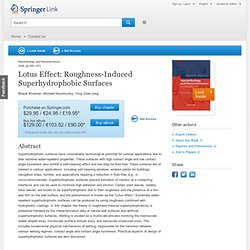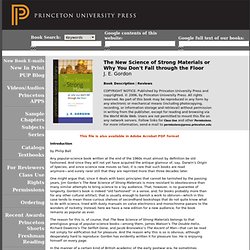

1 - Explication de la Super-Hydrophobie - TPE-EFFET LOTUS. Nous allons tout d'abord expliquer ce qu'est la tension superficielle afin d'aboutir à qu'est-ce que la super-hydrophobie.

Tout ensemble de molécules possède une tension superficielle, mesurée en newton·n^-1. Cette tension superficielle est une force présente à l'interface entre deux milieux différents. Prenons l'exemple de la goutte d'eau: ici, trois corps sont en présence: un solide quelconque sur lequel est posé la goutte d'eau, un liquide qui est l'eau est un gaz qui est presque toujours l'air. Dans ce cas, il y a donc trois interfaces: solide-liquide, liquide-gaz et gaz-solide. Certaines molécules ont la propriété de "préférer" être entourées de leur congénères: alors, elles minimisent la surface de contact entre les deux milieux. A présent nous allons présenter les liaisons hydrogènes, qui sont présentes dans l'eau. Les liaisons hydrogène sont des liaisons à faible énergie (10 à 40 kJ·mol^-1 alors que la liaison O-H est de 460 kJ·mol^-1).
Note : S = surface. Untitled. Characterization and Distribution of Water-repellent, Self-cleaning Plant Surfaces. + Author Affiliations During the last 20 years, a wealth of data dealing with scanning electron microscopy of plant surfaces has been published.

The ultrastructure of epidermal surfaces has been investigated with respect to taxonomic, as well as functional aspects. Within the latter, water-repellency has received much attention and has been well documented. Water-repellency is based on surface roughness caused by different microstructures (trichomes, cuticular folds and wax crystals), together with the hydrophobic properties of the epicuticular wax.
Non-adhesive lotus and other hydrophobic materials. Superhydrophobic Functionalized Graphene Aerogels. Lotus Effect: Roughness-Induced Superhydrophobic Surfaces. Superhydrophobic surfaces have considerable technological potential for various applications due to their extreme water-repellent properties.

These surfaces with high contact angle and low contact angle hysteresis also exhibit a self-cleaning effect and low drag for fluid flow. These surfaces are of interest in various applications, including self-cleaning windows, exterior paints for buildings, navigation ships, textiles, and applications requiring a reduction in fluid flow, e.g., in micro/nanochannels. Superhydrophobic surfaces prevent formation of menisci at a contacting interfaces and can be used to minimize high adhesion and stiction. Certain plant leaves, notably lotus leaves, are known to be superhydrophobic due to their roughness and the presence of a thin wax film on the leaf surface, and the phenomenon is known as the “Lotus effect.” Extremely water-repellent superhydrophobic surfaces can be produced by using roughness combined with hydrophobic coatings. Characterization and Distribution of Water-repellent, Self-cleaning Plant Surfaces.
Hydrophobic surface allows self-cleaning: sacred lotus. Lotus plants (Nelumbo nucifera) stay dirt-free, an obvious advantage for an aquatic plant living in typically muddy habitats, and they do so without using detergent or expending energy.

The plant's cuticle, like that of other plants, is made up of soluble lipids embedded in a polyester matrix – wax – but the degree of its water repellency is extreme (superhydrophobic). This is accomplished through the micro-topography of their leaf surfaces, which while showing a variety of structures, all share a similar mathematical set of proportions associated with superhydrophobicity.
Lotus leaves, for example, exhibit extensive folding (i.e., papillose epidermal cells) and epicuticular wax crystals jutting out from the plant's surface, resulting in a roughened microscale surface. This video gives you a closer look at the surface of the lotus leaf. Superhydrophobic behaviour of lotus-leaf. Application of titanium ..to create self-cleaning materials. Sample Chapter for Gordon, J.: The New Science of Strong Materials or Why You Don't Fall through the Floor.
This file is also available in Adobe Acrobat PDF format Introduction by Philip Ball Any popular-science book written at the end of the 1960s must almost by definition be old fashioned.

And since they will not yet have acquired the antique glamour of, say, Darwin’s Origin of Species, and since science now moves so fast, it is rare that such books are read anymore—and surely rarer still that they are reprinted more than three decades later. One might argue that, since it deals with basic principles that cannot be tarnished by the passing years, Jim Gordon’s The New Science of Strong Materials is more resistant to obsolescence than many similar attempts to bring science to a lay audience.
It is certainly “old fashioned” to speak this way today. What is perhaps most astonishing about the continuing allure of The New Science of Strong Materials, however, is that it is really a book about engineering and technology. The benefits of the broad view New functions Take silicon, for example. Maximal deformation of an impacting drop. Effect of surface composition and roughness on the apparent surface freeenergy of silica aerogel materials. A simple method for measuring the superhydrophobic contact angle withhigh accuracy.
Atomic force microscopy and thermodynamics on taro, a self-cleaning plantleaf. Design and fabrication of microcavity-array superhydrophobic surfaces. High Superhydrophobicity Achieved on Poly(ethylene terephthalate)by Innovative Laser-Assisted Magnetron Sputtering.